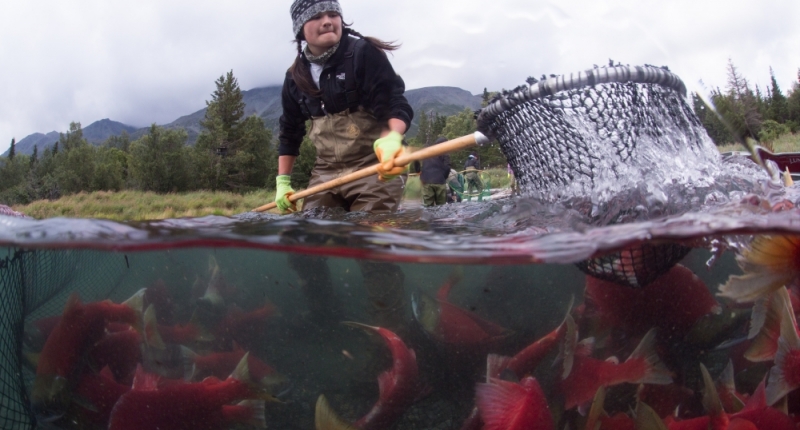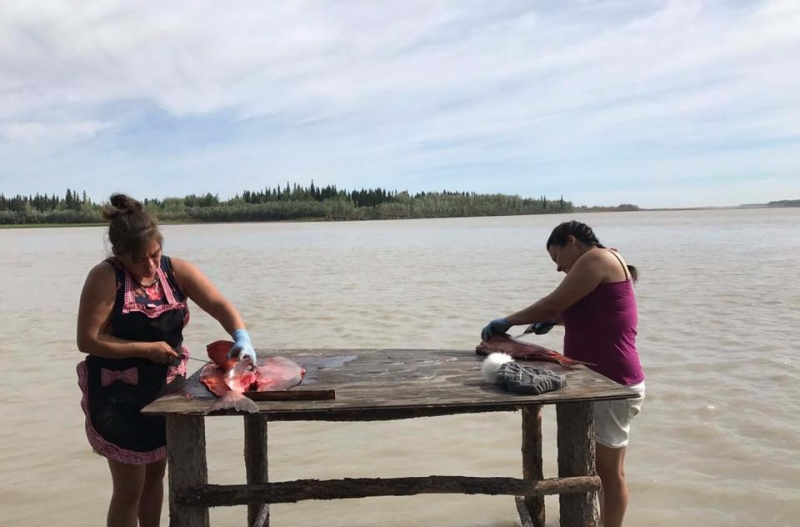Telling the Hidden Stories of Salmon

In the Yup’ik culture of Alaska, salmon are sentient beings. They are family, and thinking of them as a resource is highly offensive. They’re in charge. How you treat them determines whether they’ll return to your net next year.
This worldview, along with a diversity of other worldviews underlying Alaskans’ relationships with salmon and why they fish them, is critical to understanding the full story of the state’s salmon systems and to supporting their sustainability. Yet, these relationships have been largely absent from the thinking that typically informs salmon management.
“There has been a real cultural mismatch in terms of how our salmon are managed and local realities,” said Courtney Carothers, an associate professor at the University of Alaska Fairbanks (UAF) and anthropologist. “It’s really important that western trained scientists and managers understand there is not necessarily a shared understanding of our salmon system.”
Carothers is part of a research collaboration that is seeking to remedy this mismatch by making visible the multiplicity of human experiences that are both impacting and impacted by salmon systems in Alaska. By examining these sociocultural dimensions, they are not only helping to round out the knowledge informing management decisions but are also disrupting norms around which salmon systems have typically been studied.
“For a long time, funders have been putting a lot of effort into understanding salmon systems as these discrete biophysical, ecological systems and missing this huge piece: all of the human groups that have long depended on salmon and continue to depend on salmon, and the ways in which these relationships are so interconnected,” said Carothers.
Their work is part of a larger project called the State of Alaska Salmon and People Project (SASAP), an effort to tell the full and complicated story of the health and struggles of the state’s salmon populations and salmon-dependent human communities. A partnership between Anchorage-based Nautilus Impact Investing and the National Center for Ecological Analysis and Synthesis (NCEAS), SASAP arose from the recognition that a sustainable future for salmon and people requires collecting and preserving all of the data that exist about them and then making those data accessible and useful to all of Alaska’s people to support their decision-making.
"All salmon-connected people of Alaska and beyond have skin in the game, and the playing field needs to be leveled when it comes to the access and interpretation of salmon data,” said project lead Peter Wesley, an assistant professor at UAF and fish biologist.
A tenet of SASAP is that both the problems and solutions for sustainable salmon systems are inherently interdisciplinary and require combining multiple ways of knowing, explained Wesley. As such, the project consists of eight teams of assorted researchers and stakeholders, from government staff to Indigenous leaders, who are synthesizing existing data on the many different pieces of the salmon-and-people puzzle – from ecology to economics – and integrating western science with Indigenous knowledge.
Two of these teams are focused on sociocultural pieces. One is working to describe the deep histories and current trends among Alaska’s salmon people – such as the ways in which people use salmon and how that’s changing, associated personal and cultural values, and threats to salmon-dependent communities – and the other is exploring how salmon affect human well-being to develop a framework that can inform management.
“In Alaska, we have an incredibly unique situation where there are many cultural groups still living in their homelands with the same practices in salmon stewardship that they have had for millennia. What a unique opportunity to really synthesize what we know about those relationships,” said Carothers, who co-leads both teams.
Indeed, these intact 10,000-year-old connections are part of what makes Alaska’s salmon story exceptional. It is impossible to talk about the iconic fish without recognizing their relationships Alaskans, which can transcend the “user groups” typically delineated in state management – i.e., subsistence, commercial, recreational, and personal-use fishermen.

“The role of salmon in many Alaskans’ lives is about much more than providing income or food. For many people, their relationships, values, and cultural and occupational identities are tied to salmon,” said Danielle Ringer, a research associate at the UAF who is among the sociocultural teams’ data analysts.
Helping scientists and managers broaden their scope on how they recognize salmon-people relationships is one goal of their sociocultural work. Another is to draw attention to a host of inequities plaguing the state’s fisheries and fishing communities, including the loss of fisheries access among rural and Native Alaskan communities, the aging of the commercial fishing fleet, and the cultural and economic consequences of shrinking salmon size.
Describing these relationships and trends has required casting a wide net for data, says Ringer, for much of the evidence is not published. In addition to mining academic papers, reports, books, and raw data, the researchers looked to the stories salmon-connected people tell – histories and personal present-day accounts sourced from museum archives, tribal holdings, and people themselves.
“There is a vast amount of living, Indigenous, and local knowledge that can be hard to codify, that we want to respect and describe as possible and appropriate,” said Ringer.
Central to their work are Alaska Native perspectives and experiences, not only as “data” but also as co-producers of knowledge. From the outset, the teams have taken guidance from an advisory board that includes representatives from Indigenous communities and subsistence fishers. Their expertise has been essential for identifying key resources, incorporating expertise that is external to science, and contextualizing the work in Indigenous worldviews.
A team member who has been instrumental in designing and facilitating this process is co-leader Jessica Black, an assistant professor at UAF who studies Indigenous natural resource management and is herself an Alaska Native. She grew up in a subsistence salmon fishing community in a region known as the Yukon Flats and knows too well the consequences of not including all voices in salmon decision-making.
Black described the frustration her community felt at the harvest limitations placed on subsistence fishing in the wake of the recent collapse of the Chinook salmon population in the Yukon River. While intended to help the population recover, the limitations had serious consequences for her community – empty freezers and fish caches among them. This experience was among a series of events exposing inequities in salmon access in the state, which fueled Black’s own frustration with the system and created a perfect storm for research.
“Through my [previous] research, I knew that subsistence and one’s ability to practice their traditional ways of life lead to wellness. So, I was very concerned the issues would just increase and my people would feel not well, based on their inability to do the one thing that helps them to provide for their families and communities,” she said.
To that end, an example of how they've relied on their advisory board is in helping them identify and refine salmon-related indicators of well-being to construct an adaptable conceptual framework for considering well-being concepts in management. The wide-ranging framework includes a diversity of indicators, some of which are data deficient and thus highlight needs for moving forward, such as how people define their sense of place, whether they feel they have a voice in decision-making, and their ability to provide for their family.
The team's intent is to enable communities to use the framework to evaluate their own priorities and challenges, and to empower them to inform decision-making processes.
“Indicators pose potential concerns because they can oversimplify or be taken out of context. So this work has to be culturally grounded and rooted in local priorities and places,” said co-leader Rachel Donkersloot, who is also the Working Waterfronts Program Director at the Alaska Marine Conservation Council
Donkersloot says focusing on well-being can improve salmon management by raising questions of for whom and for what are we managing salmon. In doing so, management decisions could better account for a neglected pillar of the triple bottom line: social sustainability.
“We’ve seen the ways in which inequities in salmon management affect livelihoods and communities. We’ve also seen how critical dimensions of well-being tend to be overlooked because they’re difficult to quantify. We hope our work can facilitate improved management objectives and outcomes,” said Donkersloot.
Black says their sociocultural work is enabling them to paint a more holistic picture of salmon-and-people systems. It is underscoring the importance of including many ways of knowing when making decisions about what is data, what do those data mean, and what can be done about it.
“I hope the research can help make the system better in terms of management, that there can be the realization across the board that Indigenous people have valuable contributions and they shouldn’t be left out of decision-making, especially as it dramatically impacts their livelihoods and well-being,” said Black.
The SASAP project is funded by the Gordon and Betty Moore Foundation.
